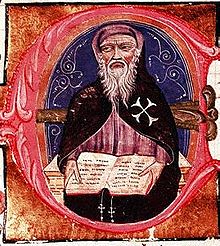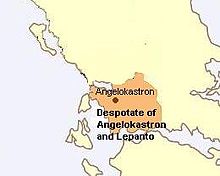| Gjin Bua Shpata | |
|---|---|
| Despot of Arta | |
| Born | First half of the 14th century Epirus |
| Died | 29 October 1399 (1399-10-30) |
| Spouse | Irene Preljubović |
| Issue | Irene Shpata & Unnamed Daughter |
| House | Shpata family |
| Religion | Eastern Orthodoxy |

Gjin Bua Shpata (sometimes anglicized as John Spata) (fl. 1358 – 29 October 1399) was an Albanian ruler in Western Greece with the title of Despot. Together with Pjetër Losha, he led raids into Epirus, Acarnania and Aetolia in 1358. He was recognized as Despot by the titular Eastern Roman Emperor in the early 1360s and ruled Aetolia (1360s–?), Angelokastron (?–1399), Naupactus (1378–1399), and Arta (1370s–1399). He was born sometime in the first half of the 14th century in Epirus, as his father was a ruler in the region.
Name
The word spata, in Albanian shpatë, pl. shpata, 'sword'. According to Orel (1998), the word was borrowed from Latin spāta. Hammond thus believes that he was called "John the Sword". Spatha being a type of Roman sword.
Life
Karl Hopf's genealogy of the Shpata family is "altogether inaccurate"; according to it, his father was Pietro, the lord of Angelokastron and Delvina (1354) during the reign of Serbian emperor Stefan Dušan (r. 1331–55). It is known that Shpata had a brother, Skurra Bua Shpata.
In 1358, some Albanian commanders overran Epirus, Acarnania and Aetolia, and subsequently established two principalities under their leaders, Shpata and Pjetër Losha.
Nikephoros II Orsini launched a campaign against the invading Albanians, and also faced with the threat of Radoslav Hlapen to the north, he negotiated with Simeon Uroš, presumably to prevent Simeon's Albanian allies from supporting the Albanians in Epirus. The negotiations were thwarted by Nikephoros' death fighting the Albanians at Acheloos (1359).

In 1360, Simeon Uroš, the titular Serbian Emperor, in an attempt to avoid conflict with the Albanians and as an acknowledgement of their military strength decided to leave the areas of Arta and Aetolia to Shpata and Losha. Shpata was "a resourceful and outstanding man in everything, a man known for his words and deeds, graceful at first sight, a man of theory and practice". It was, in a word, "the glory of the Albanian race".
The Despot of Ioannina, Thomas Preljubović, had betrothed his daughter to Losha's son in 1370, satisfying the Albanians and ending the conflict between them. In 1374, however, Pjetër Losha died of the plague in Arta, after which Shpata took the city. At this time he was not bound by agreement to Thomas, and so he laid siege to Ioannina and ravaged the countryside by defeating the forces of Preljubović. Thomas brought peace when he betrothed his sister Helena to Shpata the following year. Attacks on Ioannina continued, however, by the Malakasioi, who didn't succeed to take Ioannina in 1377 and 1379. This tribe acted independently and nor under the order of Shpata.

In 1376 or 1377, Shpata conquered Nafpaktos; by this time he controlled Arta and much of southern Epirus and Acarnania. The Achaean Knights Hospitallers of Juan Fernández de Heredia began their invasion of Epirus, moving onto Shpata, capturing Nafpaktos, and then Vonitsa in Acarnania (April 1378). However, Shpata managed to defeat and capture Heredia as a hostage, ending their campaign; he was again master of Nafpaktos by 1380. In May 1379, Shpata again devastated the countryside of Ioannina.
In 1380, Thomas made an offensive with the help of Turks reaching up to the upper Kalamas River, where however, the Albanians, in particular, the tribe of Mazaraki held their defensive position and defeated again Thomas.
In 1384 Thomas Preljubović was killed by some of his bodyguards. Gjin Bua Shpata attacked Ioannina but was unsuccessful in cracking the defense set up by Esau de' Buondelmonti. The two made peace but soon returned to the conflict. In 1386, Esau gained Ottoman military help. The Ottomans were, after the Battle of Kosovo (1389), unable to assist Esau, thus, the Albanians seized the opportunity and raided the environs of Ioannina in the summer by defeating Esau and forcing him to stay inside the city. The Malakasioi then raided into the territory, after which they concluded alliance with Shpata. Esau then allied himself with the caesar of Thessaly (either Alexios Angelos or Manuel), who defeated the Albanians, presumably the Malakasioi, later that year, but not Shpata.
In January 1396, Esau married Shpata's only daughter, Irene. The marriage was part of a deal which the archons of Ioannina enforced on Esau in order to make peace with the Albanians.
Shpata died on 29 October 1399, under the continuous pressure of Tocco. Shpata's son would become the next despot of Arta and Angelokastron for the next decade.
Legacy
The Albanian academic Gjergji Shuka distinguished the origin of some South Slavic (Jovan i divski starešina, Marko Kraljević i Đemo Brđanin, Jana i Detelin voyvoda) Albanian and legends and epic songs, such as Zuku Bajraktar, Dedalia dhe Katallani, Çika e plakut Emin agë vret në duel Baloze Delinë, and in the poem regarding Shpata and the battle of Arta in 1378. The two enemies of Gjon, Juan Fernández de Heredia and queen Joanna I of Naples, are remembered in Balkan collective memory.
Possessions
| This section does not cite any sources. Please help improve this section by adding citations to reliable sources. Unsourced material may be challenged and removed. (March 2015) (Learn how and when to remove this message) |

- Aetolia (Early 1360s–?)
- Angelokastron (?–1399)
- Acheloos (?–1399)
- Nafpaktos or "Lepanto" (1377–78; 1380–?)
- Arta (1375–99)
Family
Further information: Shpata FamilyHis genealogical tree is not well documented. It was first outlined by Karl Hopf in his Chroniques Greco-Romanes (p. 531) and by K. Sathas in the 19th century but a newer study finds that those works have many mistakes and gaps. Hopf's genealogy of the Shpata family is "altogether inaccurate".
G. Schiró studied the genealogy of Shpata based on the original sources, i.e. the "Chronicle of Ioannina" and the "Chronicle of Tocco", but also on the Venetian archives. He proposed that Pietro Bua had not only three sons but four and that John had only daughters. His daughter Irene married three times. He believes that the family was extinct with the death of Jakob in 1416. Other people, mainly condottieri, with the name "Bua" are not blood relatives of this family but this name was used by many as first name since it became famous. However this is refuted by modern scholars, Gjin Bua Shpata was a member of Bua tribe and founder of Shpata family.
He was married to a woman who is unknown in the historical record. His daughter, Irene was married (before April 1381 ) to a Marchesano of Naples, Morean baron, baillie of Achaea and Esau de' Buondelmonti in 1396. Esau was the Despot of Ioannina. Another unnamed daughter was married to Gjon Zenebishi.
Among his grandchildren were brothers Muriq Shpata and Jakob Bua Shpata, who claimed to have been sons of Eirene.
See also
References
- ^ Hammond 1976, p. 59.
- Orel 1998, p. 428.
- Hammond 1976, p. 62.
- Anthony Luttrell (1982). Latin and Greece: The Hospitallers and the Crusades, 1291-1440. Ashgate Publishing, Limited. p. 122. ISBN 978-0-86078-106-6.
- Istituto di studi bizantini e neoellenici 1968, p. 69.
- Hammond 1976, p. 59: "It was in this period that the flow of immigrants from the northwestern area began (see Maps 11-13). It became a flood in the fourteenth century. They went as mercenaries, raiders and migrants. The great majority of them were speakers of Albanian, but others joined the movement. Thus the Vlach-speaking Malakasii, who invaded Thessaly in 1334 were described as 'Albanoi' by Cantacuzenus 1.474 no less than the Albanian-speaking 'Albanensium gens' which raided Thessaly in 1325. (..) In 1358 the Albanians overran Epirus, Acarnania and Aetolia, and established two principalities under their leaders, John Spatas (shpate in Albanian meaning a sword) and Peter Leosas (lios in Albanian meaning a pockmark), Naupactus fell into their control in 1378."
- ^ Fine 1994, p. 348.
- Fine 1994, pp. 348–349.
- Nicol 2010, pp. 142, 146–169.
- Sansaridou-Hendrickx 2017, p. 292: "In 1360, avoiding conflict with the Albanian forces and admitting thus their military superiority, Symeon Uros left in their hands Aetolia, which was divided between two rulers belonging to the Albanian race (genos), namely Gjin Bouas Spatas, who became Despot of Acheloos and Angelokastron, and Peter Liosas who was made Despot of Arta, Rogoi and the region of Amphilochia"
- Pëllumb Xhufi (2016). Árbërit e Jonit. Onufri. p. 318-321.
- ^ Nicol 1984, p. 146.
- ^ Fine 1994, p. 401.
- Nicol 1984, p. 147.
- Hammond 1976, p. 59: "The Albanians and in particular the Mazarakii of the Kalamas valley held firm against him. In 1385 he was assassinated by some of his own bodyguards (Epeirotica 2.230)"
- ^ Fine 1994, p. 355.
- Sansaridou-Hendrickx 2017, p. 290: "Esau, who under the pressure of his archontes and the prelate of Ioannina to make peace with the Albanians, got engaged to the daughter of Gjin Bouas Spatas, Irene, whom he married in January 1396"
- Shuka, Gjergji, "Tridhjetë këngë dhe legjenda ballkanike: Studim mbi origjinën historike", Botimet Naimi, Tiranë, 2015, pp. 19-110
- Schiró Giuseppe, La genealogia degli Spata tra il XIV e XV sec. e due Bua sconosciouti, Rivista di Studi Bizantini e Neoellenici, Universita di Roma, Roma, 1971-1972, pp. 67-85.
- ^ Anthony Luttrell (1982). Latin and Greece: The Hospitallers and the Crusades, 1291-1440. Ashgate Publishing, Limited. p. 122. ISBN 978-0-86078-106-6.
- Schiró G. p. 81
- Studime Historike, Volume 2. the University of California. 1965. p. 17.
- Kollias 1990, p. 208-209. harvnb error: no target: CITEREFKollias1990 (help)
- Sansaridou-Hendrickx 2017, p. 299.
- Nicol 1984, p. 148.
- Skender Anamali (2002). Historia e popullit shqiptar. Botimet Toena. p. 285. ISBN 978-99927-1-622-9.
Sources
- Sansaridou-Hendrickx, Thekla (2017). "The Albanians in the Chronicle(s) of Ioannina: An Anthropological Approach". Acta Patristica et Byzantina. 21 (2): 287–306. doi:10.1080/10226486.2010.11879131. S2CID 163742869.
- Fine, John V. A. Jr. (1994) . The Late Medieval Balkans: A Critical Survey from the Late Twelfth Century to the Ottoman Conquest. Ann Arbor, Michigan: University of Michigan Press. ISBN 0-472-08260-4.
- Hammond, Nicholas Geoffrey Lemprière (1976). Migrations and invasions in Greece and adjacent areas. Noyes Press. ISBN 978-0-8155-5047-1.
- Istituto di studi bizantini e neoellenici (1968). Rivista di studi bizantini e neoellenici. Vol. 5–9, 15–19. Istituto di studi bizantini e neoellenici, Università di Roma.
- Nicol, Donald MacGillivray (1984). The Despotate of Epiros 1267–1479: A Contribution to the History of Greece in the Middle Ages. Cambridge University Press. ISBN 978-0-521-13089-9.
- Orel, Vladimir (1998). Albanian etymological dictionary. Brill. ISBN 9004110240.
| Preceded byPost created | Despot of Angelokastron and Lepanto 1359–1374 |
Succeeded byPost abolished |
| Preceded byPeter Losha | Despot of Arta 1374–1399 |
Succeeded bySgouros Spata |
| Albanian Principalities in the Middle Ages | |
|---|---|